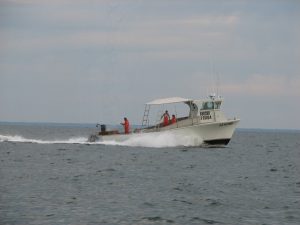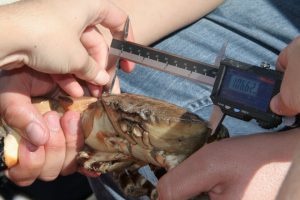Written by David Chagaris, PhD. Research Assistant Professor at UF IFAS NCBS.
 The Florida stone crab fishery operates primarily along the Gulf coast from Cedar Key to southwest Florida and the Florida Keys. The fishery is one of the most valuable in Florida, with over $30 million in revenue generated annually. This fishery is unique in that fishermen remove the claws and release the crabs back into the water, potentially facilitating a very sustainable fishery.
The Florida stone crab fishery operates primarily along the Gulf coast from Cedar Key to southwest Florida and the Florida Keys. The fishery is one of the most valuable in Florida, with over $30 million in revenue generated annually. This fishery is unique in that fishermen remove the claws and release the crabs back into the water, potentially facilitating a very sustainable fishery.
 However, the Florida stone crab fishery is currently in critical condition. Three decades of high fishing mortality combined with red tides and hypoxic ‘dark water’ events have resulted in a depleted stone crab population. The four years with the lowest landings have all occurred since 2005, and often coincided with these events. Further, proper understanding and correction of common harvest practices can drastically improve the survival of declawed crabs. For instance, wounding associated with poor technique in claw removal and leaving crabs to dry on deck make it less likely that a crab will survive after being returned to the water. Lastly, the relationship between effort and landings point to inefficiencies in the fishery and suggest that revenues can be maintained or increased at far lower costs. The high market value of stone crabs gives the appearance of a financially stable fishery while the catch trends and observations by fishermen suggest otherwise.
However, the Florida stone crab fishery is currently in critical condition. Three decades of high fishing mortality combined with red tides and hypoxic ‘dark water’ events have resulted in a depleted stone crab population. The four years with the lowest landings have all occurred since 2005, and often coincided with these events. Further, proper understanding and correction of common harvest practices can drastically improve the survival of declawed crabs. For instance, wounding associated with poor technique in claw removal and leaving crabs to dry on deck make it less likely that a crab will survive after being returned to the water. Lastly, the relationship between effort and landings point to inefficiencies in the fishery and suggest that revenues can be maintained or increased at far lower costs. The high market value of stone crabs gives the appearance of a financially stable fishery while the catch trends and observations by fishermen suggest otherwise.
 A new study funded by the Florida Sea Grant aims to improve management and harvest practices in this fishery. The project is a collaborative effort between the Nature Coast Biological Station, Florida Fish and Wildlife Conservation Commission, UF Fisheries and Aquatic Sciences Program, and Florida Sea Grant. Lead investigator Dr. David Chagaris (UF NCBS) will work with FWC scientists Dr. Claire Crowley and Ryan Gandy to develop a new model for assessing stone crab populations. Dr. Frank Asche (UF FAS) will add a bioeconomic component to the model in order to estimate the economic benefits associated with a suite of management options. Dr. Savanna Barry (UF NCBS and Florida Sea Grant) will lead a stakeholder engagement process to gather input from fishermen, demonstrate the economic benefits of better handling techniques, and gauge support for different management options.
A new study funded by the Florida Sea Grant aims to improve management and harvest practices in this fishery. The project is a collaborative effort between the Nature Coast Biological Station, Florida Fish and Wildlife Conservation Commission, UF Fisheries and Aquatic Sciences Program, and Florida Sea Grant. Lead investigator Dr. David Chagaris (UF NCBS) will work with FWC scientists Dr. Claire Crowley and Ryan Gandy to develop a new model for assessing stone crab populations. Dr. Frank Asche (UF FAS) will add a bioeconomic component to the model in order to estimate the economic benefits associated with a suite of management options. Dr. Savanna Barry (UF NCBS and Florida Sea Grant) will lead a stakeholder engagement process to gather input from fishermen, demonstrate the economic benefits of better handling techniques, and gauge support for different management options.

Because potential management options have already been identified and are essentially waiting for evaluation by the model, this project has the potential to make immediate impacts on how the stone crab fishery is managed. Another expected benefit of this project will be increased adoption and awareness in best harvest practices. Ultimately, we expect this project will result in a new management plan for the stone crab fishery to ensure it continues to rank in the top five of Florida’s most valuable fisheries. The two-year project will begin in January 2020, with stakeholder workshops planned each year for Cedar Key, west-central Florida, and southwest Florida.
 0
0
